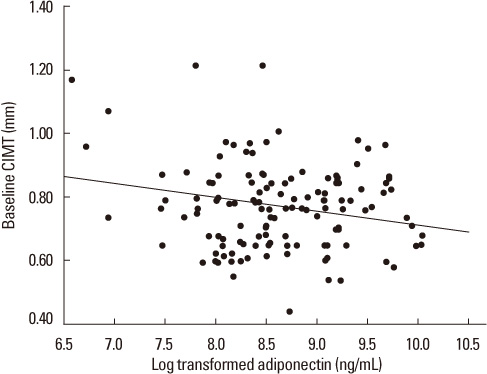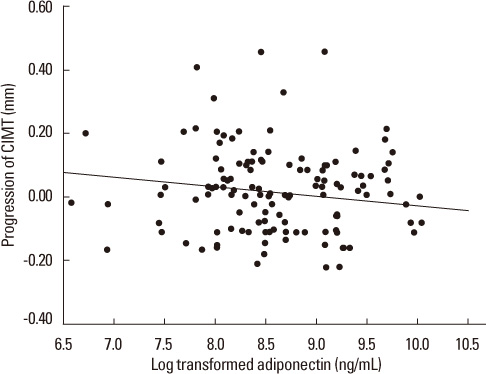Endocrinol Metab.
2012 Mar;27(1):31-38. 10.3803/EnM.2012.27.1.31.
Impact of Serum Adiponectin Concentration on Progression of Carotid Atherosclerosis in Patients with Type 2 Diabetes Mellitus
- Affiliations
-
- 1Division of Endocrinology, Department of Internal Medicine, Hallym University College of Medicine, Anyang, Korea. ironeat@gmail.com
- KMID: 2134815
- DOI: http://doi.org/10.3803/EnM.2012.27.1.31
Abstract
- BACKGROUND
Increased cardiovascular events, which is the leading cause of death in type 2 diabetic patients, are mainly caused by accelerated atherosclerosis. Adiponectin has been suggested as a risk factor for cardiovascular diseases in cross-sectional studies. However, little is known about the impact of adiponectin on the progression of carotid atherosclerosis in type 2 diabetic patients. This study was conducted to evaluate the impact of early adiponectin levels on the progression of carotid atherosclerosis.
METHODS
From March 2009, 150 patients with type 2 diabetes were consecutively enrolled in our affiliated outpatient clinic. Anthropometric and biochemical data, including adiponectin levels, were measured in each participant. We measured the carotid intima-media thickness (CIMT) at baseline and at 1-year follow-up (n = 111). Then, we prospectively studied the relationship between the serum adiponectin levels and the progression of CIMT for 1 year.
RESULTS
Adiponectin levels negatively correlated with CIMT (r = -0.219, P = 0.015). Moreover, mean progression of CIMT was 0.016 +/- 0.040 mm. However, there was no correlation between adiponectin levels and the progression of CIMT within 1-year follow-up period (r = -0.156, P = 0.080). Age (beta = 0.556, P = 0.004), LDL cholesterol (beta = 0.276, P = 0.042), and A1C (beta = 0.309, P = 0.038) were found to be independent risk factors for CIMT. However, A1C (beta = 0.311, P = 0.042) was found to be the only independent risk factor for the progression of CIMT.
CONCLUSION
In our study, adiponectin levels were negatively associated with CIMT. However, it did not affect the progression of CIMT at 1-year follow-up. Overall glycemic control is the most important factor in the progression of CIMT in patients with type 2 diabetes.
Keyword
MeSH Terms
Figure
Reference
-
1. Wilson PW, Kannel WB, Silbershatz H, D'Agostino RB. Clustering of metabolic factors and coronary heart disease. Arch Intern Med. 1999. 159:1104–1109.2. Laakso M, Lehto S. Epidemiology of macrovascular disease in diabetes. Diabetes Rev. 1997. 5:294–315.3. Hu Y, Liu W, Huang R, Zhang X. Postchallenge plasma glucose excursions, carotid intima-media thickness, and risk factors for atherosclerosis in Chinese population with type 2 diabetes. Atherosclerosis. 2010. 210:302–306.4. Ho HC, Chen MF, Hwang JJ, Lee YT, Su TC. Intima-media thickness of lower-limb arteries associated with fasting and post-challenge plasma glucose levels. J Atheroscler Thromb. 2009. 16:748–755.5. Yokoyama H, Katakami N, Yamasaki Y. Recent advances of intervention to inhibit progression of carotid intima-media thickness in patients with type 2 diabetes mellitus. Stroke. 2006. 37:2420–2427.6. Hodis HN, Mack WJ, LaBree L, Selzer RH, Liu CR, Liu CH, Azen SP. The role of carotid arterial intima-media thickness in predicting clinical coronary events. Ann Intern Med. 1998. 128:262–269.7. Langenfeld MR, Forst T, Hohberg C, Kann P, Lubben G, Konrad T, Fullert SD, Sachara C, Pfutzner A. Pioglitazone decreases carotid intima-media thickness independently of glycemic control in patients with type 2 diabetes mellitus: results from a controlled randomized study. Circulation. 2005. 111:2525–2531.8. Katakami N, Yamasaki Y, Hayaishi-Okano R, Ohtoshi K, Kaneto H, Matsuhisa M, Kosugi K, Hori M. Metformin or gliclazide, rather than glibenclamide, attenuate progression of carotid intima-media thickness in subjects with type 2 diabetes. Diabetologia. 2004. 47:1906–1913.9. Fateh-Moghadam S, Li Z, Ersel S, Reuter T, Htun P, Plockinger U, Bocksch W, Dietz R, Gawaz M. Platelet degranulation is associated with progression of intima-media thickness of the common carotid artery in patients with diabetes mellitus type 2. Arterioscler Thromb Vasc Biol. 2005. 25:1299–1303.10. Maeda K, Okubo K, Shimomura I, Funahashi T, Matsuzawa Y, Matsubara K. cDNA cloning and expression of a novel adipose specific collagen-like factor, apM1 (AdiPose Most abundant Gene transcript 1). Biochem Biophys Res Commun. 1996. 221:286–289.11. Yamauchi T, Kamon J, Waki H, Terauchi Y, Kubota N, Hara K, Mori Y, Ide T, Murakami K, Tsuboyama-Kasaoka N, Ezaki O, Akanuma Y, Gavrilova O, Vinson C, Reitman ML, Kagechika H, Shudo K, Yoda M, Nakano Y, Tobe K, Nagai R, Kimura S, Tomita M, Froguel P, Kadowaki T. The fat-derived hormone adiponectin reverses insulin resistance associated with both lipoatrophy and obesity. Nat Med. 2001. 7:941–946.12. Arita Y, Kihara S, Ouchi N, Takahashi M, Maeda K, Miyagawa J, Hotta K, Shimomura I, Nakamura T, Miyaoka K, Kuriyama H, Nishida M, Yamashita S, Okubo K, Matsubara K, Muraguchi M, Ohmoto Y, Funahashi T, Matsuzawa Y. Paradoxical decrease of an adipose-specific protein, adiponectin, in obesity. Biochem Biophys Res Commun. 1999. 257:79–83.13. Weyer C, Funahashi T, Tanaka S, Hotta K, Matsuzawa Y, Pratley RE, Tataranni PA. Hypoadiponectinemia in obesity and type 2 diabetes: close association with insulin resistance and hyperinsulinemia. J Clin Endocrinol Metab. 2001. 86:1930–1935.14. Kumada M, Kihara S, Sumitsuji S, Kawamoto T, Matsumoto S, Ouchi N, Arita Y, Okamoto Y, Shimomura I, Hiraoka H, Nakamura T, Funahashi T, Matsuzawa Y. Osaka CAD Study Group. Association of hypoadiponectinemia with coronary artery disease in men. Arterioscler Thromb Vasc Biol. 2003. 23:85–89.15. Choi KM, Lee J, Lee KW, Seo JA, Oh JH, Kim SG, Kim NH, Choi DS, Baik SH. Serum adiponectin concentrations predict the developments of type 2 diabetes and the metabolic syndrome in elderly Koreans. Clin Endocrinol (Oxf). 2004. 61:75–80.16. Lim S, Jang HC. Clinical implication of adiponectin. Korean Diabetes J. 2008. 32:85–97.17. Pilz S, Horejsi R, Möller R, Almer G, Scharnagl H, Stojakovic T, Dimitrova R, Weihrauch G, Borkenstein M, Maerz W, Schauenstein K, Mangge H. Early atherosclerosis in obese juveniles is associated with low serum levels of adiponectin. J Clin Endocrinol Metab. 2005. 90:4792–4796.18. Iglseder B, Mackevics V, Stadlmayer A, Tasch G, Ladurner G, Paulweber B. Plasma adiponectin levels and sonographic phenotypes of subclinical carotid artery atherosclerosis: data from the SAPHIR Study. Stroke. 2005. 36:2577–2582.19. Nilsson PM, Engström G, Hedblad B, Frystyk J, Persson MM, Berglund G, Flyvbjerg A. Plasma adiponectin levels in relation to carotid intima media thickness and markers of insulin resistance. Arterioscler Thromb Vasc Biol. 2006. 26:2758–2762.20. World Health Organization. WHO Expert Committee on Diabetes Mellitus. 1980. 2nd Report. Geneva: World Health Organization.21. Pyorala K, Laakso M, Uusitupa M. Diabetes and atherosclerosis: an epidemiologic view. Diabetes Metab Rev. 1987. 3:463–524.22. Kannel WB, McGee DL. Diabetes and cardiovascular disease. The Framingham study. JAMA. 1979. 241:2035–2038.23. Kannel WB. Lipids, diabetes, and coronary heart disease: insights from the Framingham Study. Am Heart J. 1985. 110:1100–1107.24. Pischon T, Girman CJ, Hotamisligil GS, Rifai N, Hu FB, Rimm EB. Plasma adiponectin levels and risk of myocardial infarction in men. JAMA. 2004. 291:1730–1737.25. Lim S, Koo BK, Cho SW, Kihara S, Funahashi T, Cho YM, Kim SY, Lee HK, Shimomura I, Park KS. Association of adiponectin and resistin with cardiovascular events in Korean patients with type 2 diabetes: the Korean atherosclerosis study (KAS): a 42-month prospective study. Atherosclerosis. 2008. 196:398–404.26. Handa N, Matsumoto M, Maeda H, Hougaku H, Ogawa S, Fukunaga R, Yoneda S, Kimura K, Kamada T. Ultrasonic evaluation of early carotid atherosclerosis. Stroke. 1990. 21:1567–1572.27. Chambless LE, Folsom AR, Clegg LX, Sharrett AR, Shahar E, Nieto FJ, Rosamond WD, Evans G. Carotid wall thickness is predictive of incident clinical stroke: the Atherosclerosis Risk in Communities (ARIC) study. Am J Epidemiol. 2000. 151:478–487.28. Allan PL, Mowbray PI, Lee AJ, Fowkes FG. Relationship between carotid intima-media thickness and symptomatic and asymptomatic peripheral arterial disease. The Edinburgh Artery Study. Stroke. 1997. 28:348–353.29. Lorenz MW, Markus HS, Bots ML, Rosvall M, Sitzer M. Prediction of clinical cardiovascular events with carotid intima-media thickness: a systematic review and meta-analysis. Circulation. 2007. 115:459–467.30. Johnson HM, Douglas PS, Srinivasan SR, Bond MG, Tang R, Li S, Chen W, Berenson GS, Stein JH. Predictors of carotid intima-media thickness progression in young adults: the Bogalusa Heart Study. Stroke. 2007. 38:900–905.31. Hodis HN, Mack WJ. Risk factor assessment, treatment strategy and prevention of coronary artery disease: the need for a more rational approach. J Intern Med. 1994. 236:111–113.32. Chambless LE, Folsom AR, Davis V, Sharrett R, Heiss G, Sorlie P, Szklo M, Howard G, Evans GW. Risk factors for progression of common carotid atherosclerosis: the Atherosclerosis Risk in Communities Study, 1987-1998. Am J Epidemiol. 2002. 155:38–47.33. Okamoto Y, Kihara S, Funahashi T, Matsuzawa Y, Libby P. Adiponectin: a key adipocytokine in metabolic syndrome. Clin Sci (Lond). 2006. 110:267–278.34. Yamauchi T, Nio Y, Maki T, Kobayashi M, Takazawa T, Iwabu M, Okada-Iwabu M, Kawamoto S, Kubota N, Kubota T, Ito Y, Kamon J, Tsuchida A, Kumagai K, Kozono H, Hada Y, Ogata H, Tokuyama K, Tsunoda M, Ide T, Murakami K, Awazawa M, Takamoto I, Froguel P, Hara K, Tobe K, Nagai R, Ueki K, Kadowaki T. Targeted disruption of AdipoR1 and AdipoR2 causes abrogation of adiponectin binding and metabolic actions. Nat Med. 2007. 13:332–339.35. Juonala M, Saarikoski LA, Viikari JS, Oikonen M, Lehtimäki T, Lyytikäinen LP, Huupponen R, Magnussen CG, Koskinen J, Laitinen T, Taittonen L, Kähönen M, Kivimäki M, Raitakari OT. A longitudinal analysis on associations of adiponectin levels with metabolic syndrome and carotid artery intima-media thickness. The Cardiovascular Risk in Young Finns Study. Atherosclerosis. 2011. 217:234–239.36. Tsushima M, Terayama Y, Momose A, Funyu T, Ohyama C. Progression of atherosclerosis in hemodialysis patients: effect of adiponectin on carotid intima media thickness. J Atheroscler Thromb. 2008. 15:213–218.37. Nguyen QM, Toprak A, Xu JH, Srinivasan SR, Chen W, Berenson GS. Progression of segment-specific carotid artery intima-media thickness in young adults (from the Bogalusa Heart Study). Am J Cardiol. 2011. 107:114–119.38. Stork S, Bots ML, Angerer P, von Schacky C, Grobbee DE, Angermann CE, Seufert J. Low levels of adiponectin predict worsening of arterial morphology and function. Atherosclerosis. 2007. 194:e147–e153.39. Pajvani UB, Du X, Combs TP, Berg AH, Rajala MW, Schulthess T, Engel J, Brownlee M, Scherer PE. Structure-function studies of the adipocyte-secreted hormone Acrp30/adiponectin. Implications fpr metabolic regulation and bioactivity. J Biol Chem. 2003. 278:9073–9085.
- Full Text Links
- Actions
-
Cited
- CITED
-
- Close
- Share
- Similar articles
-
- Impact of the Serum Adiponectin Concentration on the Progression of Carotid Atherosclerosis in Patient with Type 2 Diabetes Mellitus
- Effects of the Serum Adiponectin to Tumor Necrosis Factor-alpha (TNF-alpha) Ratio on Carotid Intima-Media Thickness in Newly Diagnosed Type 2 Diabetic Patients
- The Role of Plasma Adiponectin and Polymorphism of Adiponectin Gene in the Development of Type 2 Diabetes Mellitus
- Non-invasive Methods for Cardiovascular Risk Assessment in Asymptomatic Type 2 Diabetes Mellitus
- Adiponectin and Diabetes Mellitus



